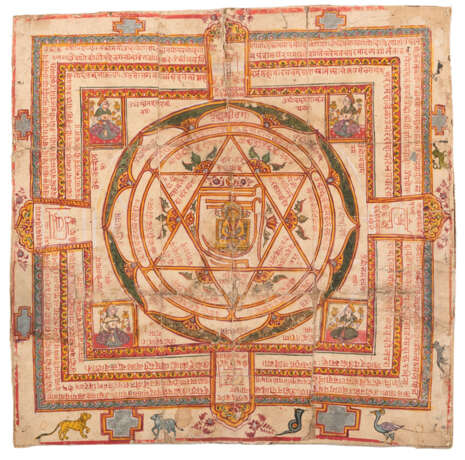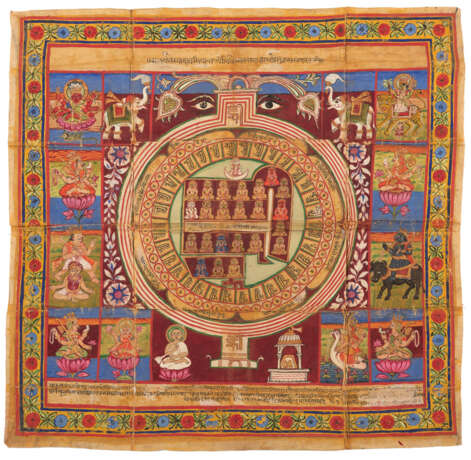ID 972900
Lot 1859 | Zwei jainistische Yantra und Jambudvīpa
Estimate value
€ 1 200 – 1 800
65 x 68/ 47 x 47/63 x 64 cm
I: Das farbenprächtig verzierte Yantra mit einem Rahmendekor aus blauen und roten Blüten zeigt ein kreisförmiges Diagramm in Form eines Lotus mit aufgemalten Mantren und der heiligen Silbe hṛīṃ im Zentrum. Darauf angeordnet sind die vierundzwanzig Jinas mit jeweils unterschiedlicher Körperfarbe. Das Yantra ist als stilisierte Vase mit verkleinertem Fuß geformt, geschmückt mit seitlich angebrachten Zierschlaufen und zwei rankenartigen Blättern. Unterhalb des Yantra ist ein jainistischer Mönch mit weißer Robe platziert, ihm gegenüber ein Schrein mit Fußabdrücken eines Heiligen. Die weiße Mönchsrobe verweist auf die jainistische Hauptrichtung der Śvetāmbara (Sanskrit: „weißgekeidete [Mönche und Nonnen]“). Um das Yantra herum sind in abgeteilten Bildflächen zehn Gottheiten mit ihren Tragtieren abgebildet. Die Aufschrift am unteren Bildrand enthält nennt ein Datum Samvat 1791, was im der Vikram-Zeitrechnung dem Jahr 1734 AD entspricht. II: Das Yantra besteht aus einer achtblättrigen Lotusblüte, eingefasst von einem dreifachen, quadratischen Rahmen, der die Mauern des Samavasaraṇa symbolisiert und somit das Motiv der ersten Predigt des Jina in dem von den Göttern errichteten Bauwerk mit dem magischen Diagramm (yantra) kombiniert. Der Grundriss des samavasaraṇa ist hier quadratisch, gut erkennbar sind die mit Zinnen bewehrten drei Ringmauern mit vier Portalen. Im Innern der Blüte, die das Innere des Bauwerks bildet, ist ein Hexagramm (Sanskrit: ṣaṭkoṇa) abgebildet, in dessen Mitte sitzt ein Jina, eingefasst von den heiligen Silben hṛīṃ und auṃ. Um die Lotusblüte herum sind vier Göttinnen platziert, vor den Mauern des Samavasaraṇa befinden sich an jeder Seite zwei kleine Teiche, die jeweils von zwei „verfeindeten“ Tieren (damit sind Fressfeinde gemeint) flankiert sind, die der Predigt friedlich zuzuhören. III: Die Malerei zeigt den Zentralkontinent Jambudvīpa der mittleren Welt entsprechend der traditionellen Kosmologie des Jainismus. Die kreisförmige Landmasse wird von mehreren horizontal verlaufenden und farbig markierten Gebirgsketten in verschiedene Zonen gegliedert und ist eingerahmt vom ringförmigen Salzozean. Das Meer ist mit verschiedenen Symbolen versehen, u.a. mit vier dreifarbigen Krügen, von denen nach jainistischer Überlieferung die Gezeiten ausgehen. Die Aufschriften sind in Gujarati-Schrift ausgeführt und verweisen somit auf den Herstellungsort im westindischen Unionsstaat Gujarat.
| Address of auction |
Nagel Auktionen GmbH Neckarstrasse 189 - 191 70190 Stuttgart Germany | ||||||||||||||
|---|---|---|---|---|---|---|---|---|---|---|---|---|---|---|---|
| Preview |
| ||||||||||||||
| Phone | +49 (0)711 649 690 | ||||||||||||||
| Fax | +49 (0)711 649 69696 | ||||||||||||||
| Buyer Premium | 29,5% | ||||||||||||||
| Conditions of purchase | Conditions of purchase | ||||||||||||||
| Business hours | Business hours
|





